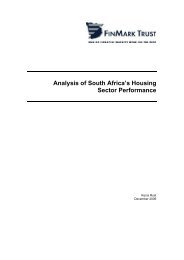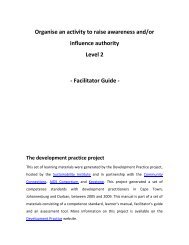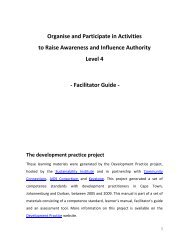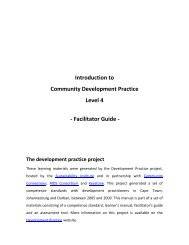the struggle for integrated sustainable settlements.
the struggle for integrated sustainable settlements.
the struggle for integrated sustainable settlements.
You also want an ePaper? Increase the reach of your titles
YUMPU automatically turns print PDFs into web optimized ePapers that Google loves.
HOUSING EVOLUTION AND<br />
BREAKING NEW GROUND (BNG)<br />
Traditionally, delivery of housing to middle and upper income housing classes has been<br />
left almost entirely to <strong>for</strong>-profi t developers operating via traditional market mechanisms and mortgagesecured<br />
fi nancing, while housing <strong>for</strong> <strong>the</strong> urban poor has been regarded as a welfare function, directly<br />
facilitated by <strong>the</strong> state. This dualism in housing policy and delivery systems underlies <strong>the</strong> fact that <strong>the</strong><br />
housing delivery processes aimed at <strong>the</strong> needs of <strong>the</strong> urban poor suffer from severe capacity problems<br />
and cannot draw on <strong>the</strong> resources located in <strong>the</strong> traditional housing and property markets. This is not<br />
<strong>sustainable</strong>.<br />
In contradistinction to <strong>the</strong> dualism referred to above, a holistic housing strategy should channel substantial<br />
allocations of subsidies via mechanisms that enable access <strong>for</strong> <strong>the</strong> poor to established housing and property<br />
markets. Following <strong>the</strong> 1994 White Paper on housing, state policy under Joe Slovo (<strong>the</strong>n national minister of<br />
housing) and Billy Cobbett (<strong>the</strong>n director-general in <strong>the</strong> national department of housing) attempted to achieve<br />
<strong>the</strong> above objective through providing subsidies <strong>for</strong> developers to deliver houses <strong>for</strong> <strong>the</strong> poor, but this was<br />
only partially successful.<br />
The root cause of <strong>the</strong> problem was – and still is - land policy; <strong>the</strong> poor were settled in economically dead,<br />
peripheral zones, where land was cheapest, hence justifying housing that could be af<strong>for</strong>dably covered<br />
by <strong>the</strong> state’s capital subsidy. This resulted in mass subsidised housing estates emerging on <strong>the</strong> urban<br />
peripheries, effectively segregated from middle and upper income housing which was better located in<br />
relation to urban facilities. This was in direct contradiction to <strong>the</strong> central principle of <strong>sustainable</strong> housing <strong>for</strong><br />
<strong>the</strong> poor, namely that <strong>the</strong>y should be located within urban spaces where land values are driven by active<br />
market <strong>for</strong>ces 2 .<br />
In contrast, <strong>the</strong> National Department of Housing’s Breaking New Ground (BNG) policy emphasises <strong>the</strong> need<br />
to create <strong>integrated</strong> human <strong>settlements</strong>. BNG intends <strong>for</strong> geographical spatial integration of all residential<br />
communities and <strong>the</strong> accompanying necessary social facilities, places of work, etc, through <strong>the</strong> state<br />
intervening in property markets, by making land available at af<strong>for</strong>dable prices and through providing subsidies<br />
to affect <strong>the</strong> structure and outputs of <strong>the</strong> housing markets. In line with BNG <strong>the</strong> Cape Town IDP (CCT. 2007),<br />
<strong>for</strong> example, has identifi ed seven strategic areas of focus, one of which is <strong>integrated</strong> human <strong>settlements</strong>. The<br />
core objectives <strong>for</strong> <strong>integrated</strong> human <strong>settlements</strong> include:<br />
page 10<br />
2 The reason <strong>for</strong> <strong>the</strong> peripheralisation of subsidised housing is that land re<strong>for</strong>m after 1994 was defined purely in terms of “rural land”, i.e. <strong>the</strong> agrarian question, and<br />
<strong>the</strong>n allocated to <strong>the</strong> Department of Agriculture and Land Affairs. Land re<strong>for</strong>m was not applied to <strong>the</strong> urban context, resulting in <strong>the</strong> marginalisation of <strong>the</strong> urban<br />
poor to <strong>the</strong> urban peripheries, despite <strong>the</strong> obvious dysfunctionalities of locating housing on <strong>the</strong> urban peripheries relatively far away from work opportunities<br />
and social facilities, subsidised as a welfare function with <strong>the</strong> private sector as implementer. This was <strong>the</strong> context that prevented <strong>the</strong> creation of <strong>integrated</strong><br />
communities (in race and class terms).








